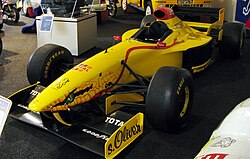Jordan 197
 |
|||||||||||
| Category | Formula One | ||||||||||
|---|---|---|---|---|---|---|---|---|---|---|---|
| Constructor | Jordan | ||||||||||
| Designer(s) | Gary Anderson | ||||||||||
| Predecessor | 196 | ||||||||||
| Successor | 198 | ||||||||||
| Technical specifications | |||||||||||
| Chassis | carbon-fibre and honeycomb composite structure | ||||||||||
| Suspension (front) | Double wishbones, pushrod | ||||||||||
| Suspension (rear) | Double wishbones, pushrod | ||||||||||
| Axle track | Front: 1,700 mm (67 in) Rear: 1,618 mm (63.7 in) |
||||||||||
| Wheelbase | 2,950 mm (116 in) | ||||||||||
| Engine | Peugeot A14, 3,000 cc (183.1 cu in), 72° V10, NA, mid-engine, longitudinally mounted | ||||||||||
| Transmission | Jordan 7-speed semi-automatic | ||||||||||
| Weight | 600 kg (1,300 lb) | ||||||||||
| Fuel | Total | ||||||||||
| Tyres | Goodyear | ||||||||||
| Competition history | |||||||||||
| Notable entrants | Benson & Hedges Jordan Peugeot | ||||||||||
| Notable drivers | 11. 12. |
||||||||||
| Debut | 1997 Australian Grand Prix | ||||||||||
|
|||||||||||
| Constructors' Championships | 0 | ||||||||||
| Drivers' Championships | 0 | ||||||||||
The Jordan 197 was the car with which the Jordan Formula One team used to compete in the 1997 Formula One season. It was driven by Ralf Schumacher and Giancarlo Fisichella, who were both in their first season with the team. Ralf was a complete rookie to F1, and Fisichella had only a part-season with Minardi behind him. It was seen as a gamble on the part of Eddie Jordan to recruit two young, inexperienced drivers to replace Rubens Barrichello and Martin Brundle.
After a disappointing season in 1996, the team seemed revitalised for 1997. The car gave Jordan the chance to seriously challenge the "Big Four" teams of that time - Williams, Ferrari, Benetton and McLaren. After a couple of races to get going, Schumacher and Fisichella scored points at almost every race (apart from a barren spell at the end of the year) and took three podium finishes. Fisichella was particularly impressive, and there was a behind-the-scenes battle for his services in 1998 between Jordan and Benetton. The only downside to the season was the failure to score the team's elusive first win in F1.
The car was also notable for its distinctive bright yellow livery, as title sponsor Benson & Hedges chose to change the colour from gold. The cars also had a snake painted on either side of the nosecone, a forked tongue that extended back around the sides of the driver's cockpit, and numerous scale effects on other parts to the car. When Grands Prix were held in countries that did not allow tobacco advertising, the cars were labelled "Bitten & Hisses" or "Ssssschuey"/"Fisssssssi" instead of "Benson & Hedges".
...
Wikipedia
